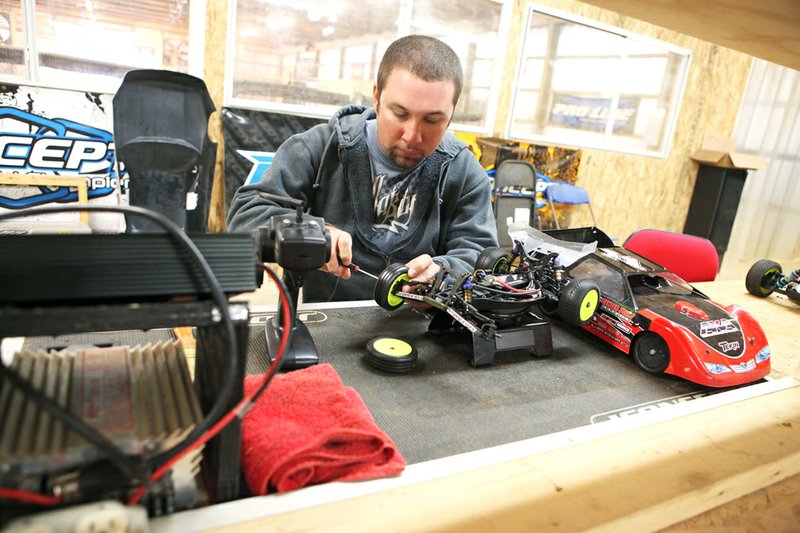BEEBE — Racing tiny cars may seem like child’s play, but at Thunder Valley RC Raceway, it’s a much more competitive matter.
Twice a month, racers from around ages 6 to 60 gather in a warehouse-like building off a gravel road in Beebe to race radio-controlled cars that they spend hundreds of dollars and hours of work perfecting. The cars are either one-tenth or one-eighth to scale of a typical race car. The smaller cars run on the indoor tracks, while the larger models hit the dirt outside.
“It’s a great hobby,” said John Warner, owner of Thunder Valley. “It’s a lot like model airplanes, but cheaper.”
Working on the model cars helps racers understand how larger cars work, said Warner, giving them a chance to learn about the geometry and physics involved in vehicle engineering.
“It’s takes maybe $200 to $300 to get into the sport, and there are endless options in upgrades and parts after that,” Warner said.
The cars may be small, but they’re mighty quick, going around 160 feet in less than six seconds. Each race day at the track sees around 50 entries, with 40 or 50 races occurring over the five-hour span of the day. When it’s their race, drivers stand on a wooden stand overlooking the track. Controllers can cost $600 or more and typically feature a trigger to control acceleration and a turn knob to control turning. Each time a car travels around the track, it passes under a pole that receives signals from transponders within each car. These signals are sent to Warner’s laptop for an official score. On race days, three qualifying races are held per class. Classes include two-wheel drive and four-wheel drive, as well as a rookie class and more.
Both oval and off-road races are held, with oval races taking place on just the outer ring of the outdoor track and off-road races utilizing the winding, hill-filled center section that can send cars flying. After drivers have completed a race, they stand on the track to serve as “turn marshals,” righting cars that flip during the race.
“[Flips are] gonna happen in almost every race,” Warner said. “It happens even to our best drivers.”
While the best action may seem to be on the racetrack, it’s the pit area that really gets buzzing on race days. The enclosed pit room features numbered work tables assigned to registered drivers. Drivers end up spending the majority of their time in the pit, fixing their cars and catching up as they wait for their race.
“The people I’ve met racing are some of my best friends,” said Chase Phillips, 25, who began racing two years ago. “Everybody’s equal here, no matter what they do.”
Although Phillips and Warner said there’s a competitive spirit to the hobby and some fierce rivalries between racers, it’s all in good fun.
“There’s always something funny happening during races,” Phillips said. “Lots of facial expressions. Some guys try to follow the cars with their remote, jerking it up and down over bumps.”
Though he’s only gotten heavily into the hobby in the past couple of years, Phillips now creates custom bodies and does graphic work for RC cars for fun.
Warner has seen interest in the hobby increase quite a bit since his track was built in 2009. At the time, it was the only indoor racetrack in the state, and racers were mostly adults.
“Now we’ve got lots of kids and teens in the rookie division,” Warner said. “Kids really pick it up faster than adults with all the video games they play.”
Warner got into RC car racing about four years ago after racing a larger car proved too costly. He opened the indoor track with the hope of providing an organized, professional environment for events that are often held at less cared-for casual tracks in backyards.
After being open three seasons, Thunder Valley now attracts competitors from Missouri, Oklahoma, Tennessee and Louisiana. While his track is no longer the only indoor one in the state, “you’d have to travel to Jackson, Miss., or Dallas for one this size,” Warner said.
The indoor track at Thunder Valley measures 60-by-80 feet. A new outdoor off-road track is currently being finished and will measure 90-by-120 feet when complete in a few weeks.
The next race day at Thunder Valley is scheduled for Dec. 15. Entry fees vary, and more information can be found online at thundervalleyrcraceway.com.
Staff writer Emily Van Zandt can be reached at (501) 399-3688 or evanzandt@arkansasonline.com.
